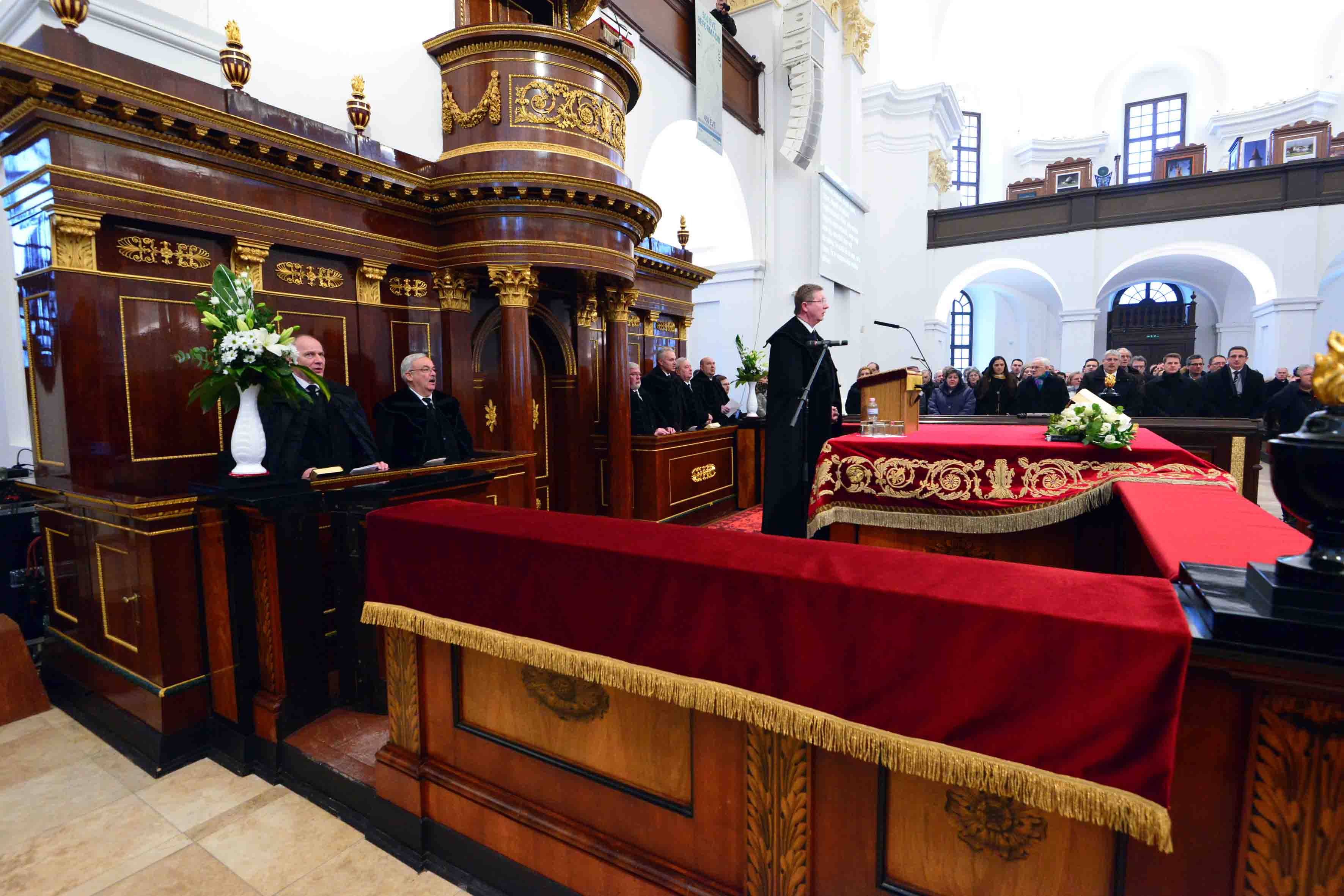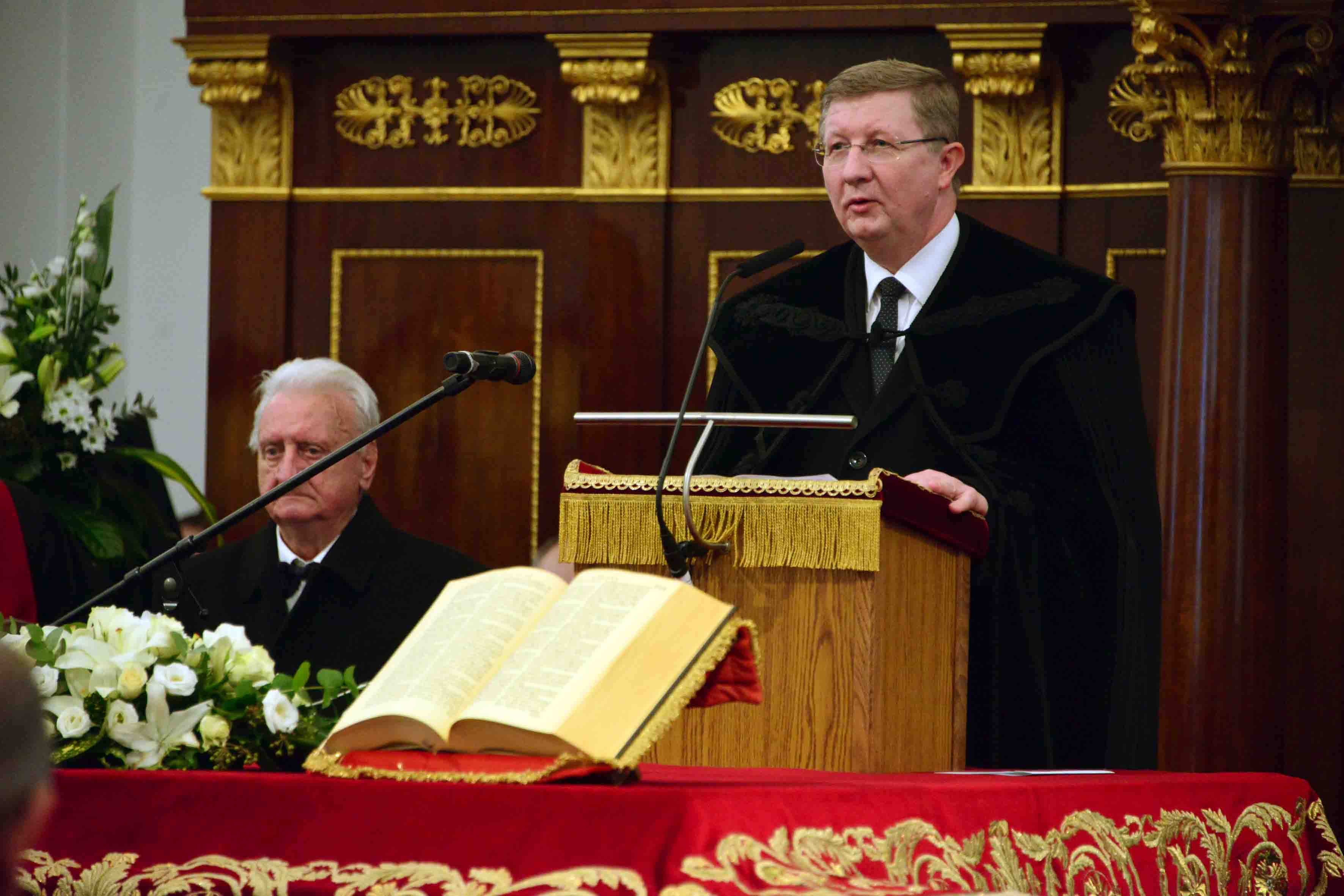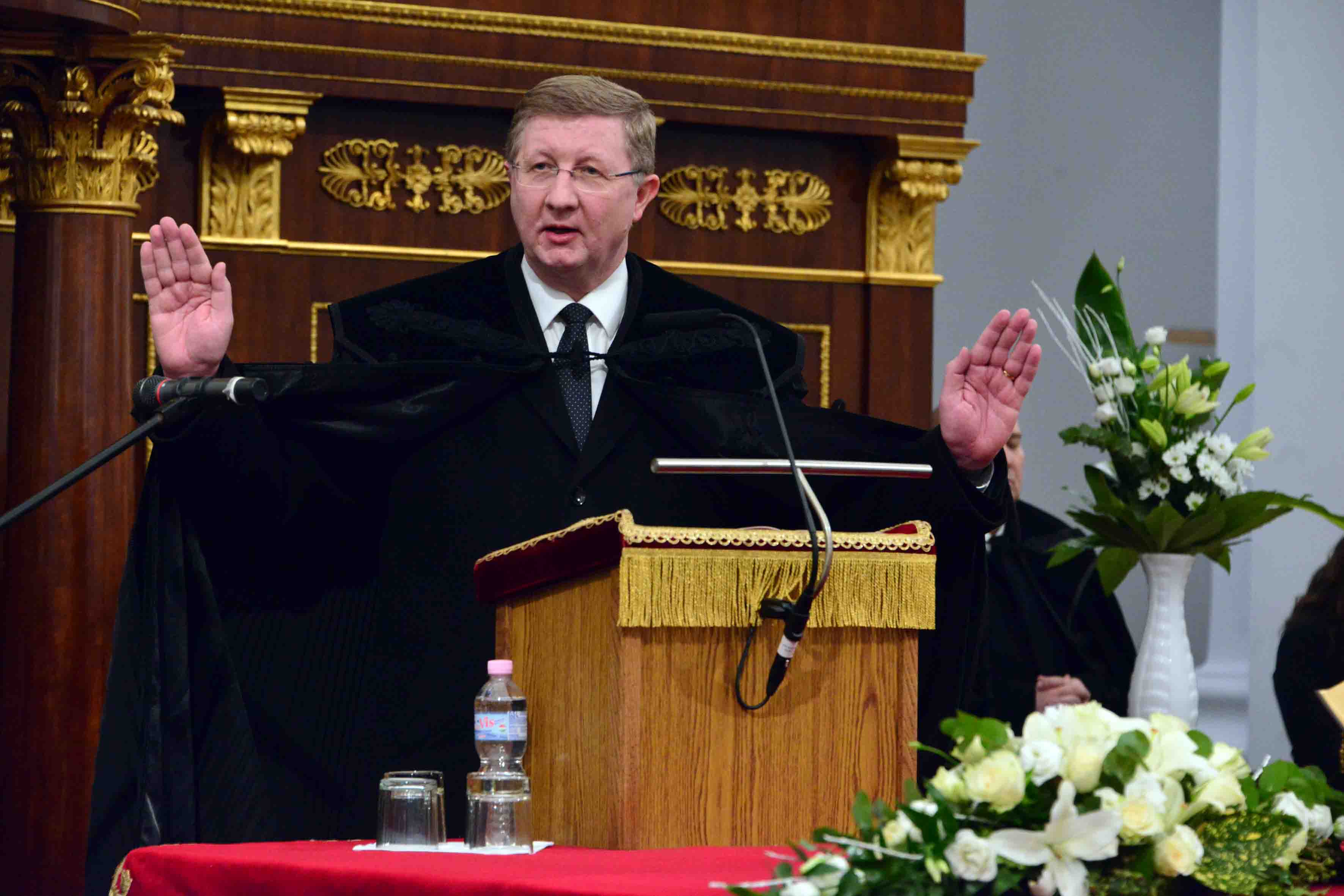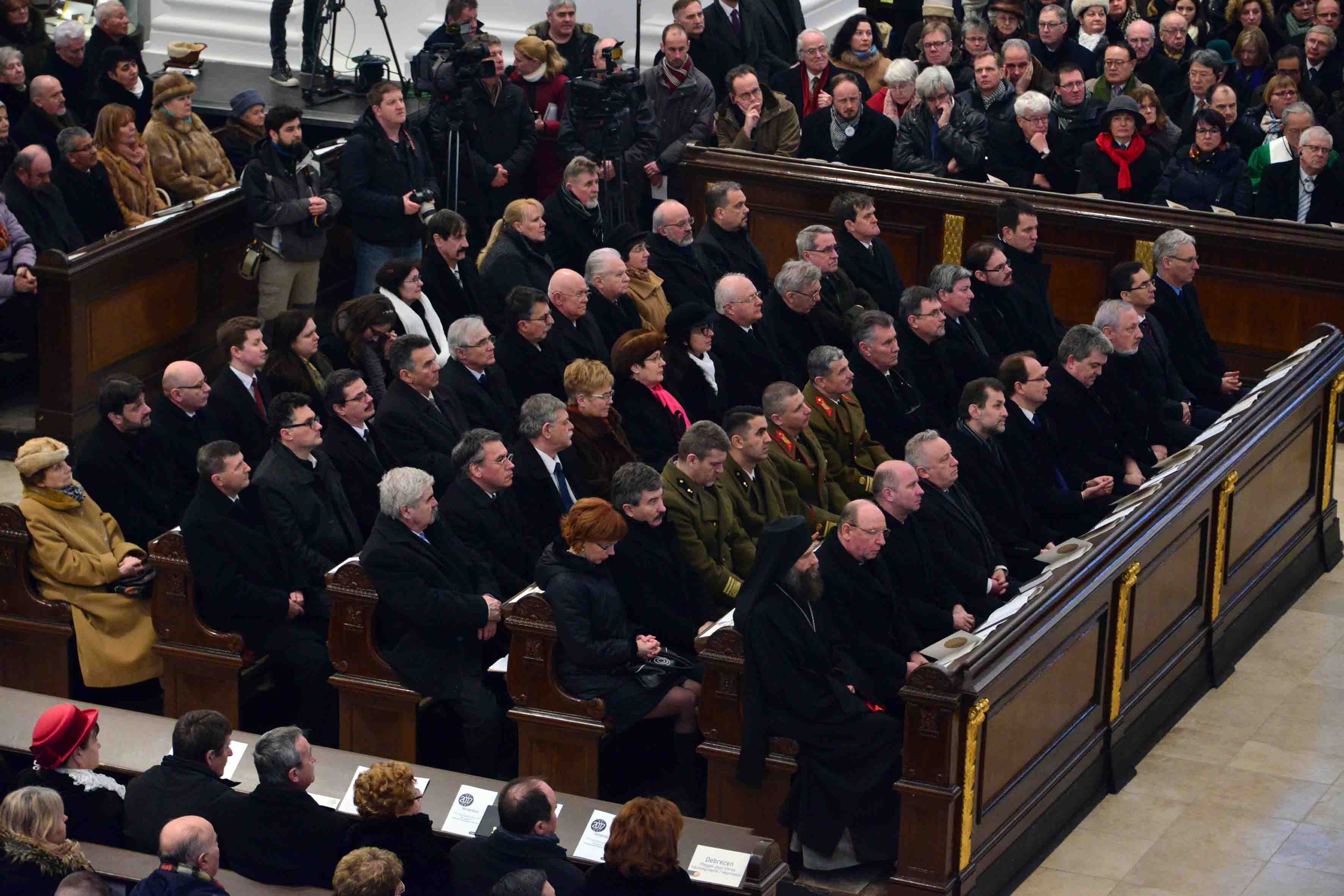Sorsközösségben egymással és a Krisztus-történettel - Fekete Károly ünnepi beszéde január 31-én
Sorsközösségben egymással és a Krisztus-történettel
- Ünnepi beszéd a Reformáció Emlékévének református megnyitó istentiszteletén –
Fekete Károly püspök, Tiszántúli Református Egyházkerület
A Magyarországi Református Egyház Zsinatának lelkészi alelnöke
(Debreceni Nagytemplom, 2017. január 31.)

Kedves Testvéreim! Hálaadó Gyülekezet!
Szentháromsághoz kötött élet
A Tiszántúli Református Egyházkerület pecsétjén – egy olyan egyházban, amely nem használ képeket egészen meglepő módon – egy képi ábrázolás van: Jézus megkeresztelkedésének pillanata.[1] A képen együtt látjuk a Mennyei Atya, a Fiú és a Szentlélek attribútumait, hogy a hitelesítő bélyegző minden lenyomata a Szentháromság Egy Igaz Istenre emlékeztesse azt, aki látja ezt a képet.
A ma is használatos pecsét eredete Wittenbergig és a Wittenbergben tanuló Melius Juhász Péterig (1536 körül – 1572, 1), Debrecen reformátoráig visz vissza bennünket. Ezzel is bizonyítva: a magyar reformáció szinkronban haladt az Európai reformációval, és annak integráns részévé vált.
Wittenbergben minden coetustag köteles volt esküvel elhatárolódni az antitrinitárius tanításoktól (Formula Iuramenti) és hitet tenni a Szentháromság mellett.[2] Ezért is lett Melius a hazai antitrinitárizmus elleni harc kiemelkedő egyéniségévé. Nem csoda, ha Melius 1565-ben megjelent Jób könyve fordításában a nyomdász, Raphael Hoffhalter (1525 körül – 1568) a Krisztus megkeresztelkedését ábrázoló fametszetes táblával nyitja a kötetet, majd 1567-ben, 450 évvel ezelőtt a Melius szerkesztette Debreceni Hitvallásban azt tanítja Istenről, hogy az Atya a szózatban, a Fiú férfi alakban, a Szentlélek a galamb képében nyilatkoztatta ki magát[3]: „Ez az én szeretett Fiam, benne gyönyörködöm”, „őt hallgassátok!” (Mt 3,17.; 17,5c) Debrecen ezzel a Szentháromságba vetett hit bástyája lett. Melius Juhász Péter hitvitái benne tartották egyházunkat a keresztyén hagyomány fő sodrában. Egyházkerületünk jelképe református identitásunk két pillérére utal: a Szentháromságba vetett hit megvallására és Isten Igéjének az egyéni és az egyházi élet középpontjába állítására.
Máig ható üzenet ez: az ember élettörténetét Isten felveszi a maga történetébe. Életünk a Krisztus-történetbe ágyazódik: „nem az önmagamé, hanem az én hűséges Uramnak és Megváltómnak… tulajdona vagyok” (HK 1., 1), aki „a világ kezdetétől a világ végezetéig… kiválasztott gyülekezetet gyűjt magának” (HK 54).
Ez lett egyetlenegy vigasztalása a Mohács után összeomlott, élet-halál harcát vívó magyarságnak.
Krisztus-történettel átszőtt öt évszázad
Az ország három részre szakadása és a török hódoltság miatt a magyar protestantizmus, miközben természetes része volt az európai reformációnak, sajátos jelleget öltött. Míg osztozott Luther örök emberi kérdésében: „Hogyan találok egy kegyelmes Istent?”, addig egy másik kérdésre is keresnie kellett a választ: „Miért engedi Isten a nemzet összeomlását?” A magyar reformátusság sajátossága lett, hogy az egyéni üdvösségkeresésen túl szem előtt tartotta a közösségi felelősségtudatot, ébren tartva szívében a vallásszabadság és a nemzeti függetlenség vágyát. Emiatt lett magyar nemzeti emlékhely a Nagytemplom, ahol a XIX. századi magyar nemzeti függetlenségi törekvések emblematikus történelmi eseményei zajlottak. A magyar református történetben tehát összekapcsolódik az egyéni üdvösség és a közösségi felelősségvállalás ügye.
A szélesebb értelemben vett nyugati protestantizmus részeként fejlődő magyar reformátusság történetében négy jellegzetesség rajzolódik ki:
Az első: a Biblikus kegyességű református spiritualitás, amely mentes a rajongástól.
A második: a szociális elkötelezettség, amely a templom – iskola – szeretetszolgálat triumvirátusában éli hétköznapjait.
A harmadik: a teológiai és világi tudományossággal való élő kapcsolat, amelyet a debreceni költő, Kiss Tamás így verselt meg: „Osztogatta kincsét a / híres bibliotéka / kibe négy század óta / hazajött Európa”.
A negyedik jellegzetesség: a közösség hűséges szolgálata, amely az első világháború után, amikor a magyar reformátusság jelentős része kettős – nemzeti és vallási – kisebbségi helyzetbe került, kontextuális feladattá vált a nemzeti, kulturális, nyelvi és hitbeli identitás megőrzése.
A reformáció beírta magát Debrecen és a magyarság történetébe. Debrecen és a magyar reformátusság pedig beírta magát a világ reformátussága és a világkeresztyénség történetébe. Ma is részesei vagyunk ennek a közös történetnek. Hisszük, hogy életünk szálait Isten beleszövi az Ő történetének, a Krisztus-történetnek a szövetébe. Ennek tudatában adunk hálát református egyházunk Krisztus-történettel átszőtt öt évszázadáért!

Sorsközösség és történeteink megosztása
A reformáció 500. évfordulóján párbeszédre hívjuk saját közösségeinket és testvéregyházainkat Debrecenben, Magyarországon, a Kárpát-medencében, Európában és az egész világon, hogy kölcsönösen osszuk meg és cseréljük ki a történeteinket. Így kerülünk igazán sorsközösségbe egymással és a Krisztus-történettel.
A jubileumi esztendő lehetőséget ad arra, hogy elmondjuk egymásnak, mit tapasztaltunk az úton, ugyanakkor annak is kitüntetett alkalma ez az év, hogy tanúságot tegyünk arról, hogyan ismertük fel életünkben a súlyos történelmi traumák közben a Krisztus-történet valóságát. Megújulásunkat segíti, ha a közelmúlt sok elbeszélendő és kibeszélendő tapasztalatát megoszthatjuk egymással.
A XX. század közepe töréspontot jelent a nyugati kultúra, a keresztyénség és a magyar reformátusság történetében. A két világháború borzalmai alapjaiban rendítették meg a „keresztyén” civilizáció krisztusi minőségébe vetett hitet. A magyar reformátusságra pedig rázárult az ateista ideológiára alapított szovjet világbirodalom burája.
Miközben a nyugati keresztyénség, benne protestáns testvéreink a Holokauszt és a gyarmatbirodalmak felbomlása örökségének feldolgozására és teológiai reflektálására tettek kísérletet, addig mi itt, a vasfüggöny mögött, egy nyomasztó, kompromisszumokkal és megalkuvásokkal terhelt, zárt világban vegetálva, egyre inkább „szétfejlődtünk” nyugati testvéreinktől.
Bizony, nem jártunk végig olyan szellemi-teológiai utakat együtt a nyugati vagy a globális Délen élő testvéreinkkel, amelyek a szekularizálódás és a gyakorlati materializmus[4] jelenségeivel dörömbölnek az egyház kapuján. Fejtörést és gondot okoz, hogy az elbontott politikai vasfüggönyön kulisszái mögött még mindig masszív a lelki-szellemi vasfüggöny és kísért a partikularizmusba kapaszkodás. Sokat és mélyebben kell még tanítanunk a javak istenítésének veszélyeiről, amely a mohó meggazdagodás, az uralkodni vágyás és az erőszak triászával kétségbeejtő aknamunkát képes végezni.
De a történetünk része az is, hála Istennek, hogy megőriztünk több alapértéket: biblikus kegyességet, énekkultúrát, a gyülekezeti közösség szeretetét, gyülekezetorientált teológiai képzést, lokálpatrióta ragaszkodást. Mindig is a világkeresztyénség és a protestáns közösség részének tartottuk magunkat, de negyven év izoláció alatt igencsak mások lettünk.
Amikor a kommunizmus összeomlott, kicsit olyanok voltunk, mint amikor valaki hosszú hibernációból ébred fel. Visszatértünk teljes értékű tagként és partnerként a világkeresztyénség és a világ protestantizmusának nagy közösségébe, de úgy éreztük magunkat, mintha egy más világba érkeztünk volna. És úgy is néztek ránk nyugati vagy keleti testvéreink, mint valami múltból érkezett időutazóra.
A reformáció 500., és a magyar református egyház 450. évfordulója lehetőséget kínál arra, hogy ne csak formális résztvevői legyünk a protestantizmus XXI. századi történetének, hanem tegyünk erőfeszítéseket arra, hogy megismerjük és megértsük önmagunkat és egymást is.
Megszabadítva a megújulásra
A közelmúlt történelmi bizonytalanságai után és a bizonytalan lét közben életfontosságú megerősödni abban, hogy a kegyelmes Isten ma is megtalálható. Feldolgozhatatlan múlttal, megszakadt egyháziassággal, szétmálló népegyházi keretek romjain is van kegyelem. Az igazi jubileumi évet nem mi rendezzük, hanem Isten ajándékozza nekünk: van szeretett Fiú, van kiben gyönyörködni, van kire hallgatni! „Nincsen azért most már semmiféle kárhoztató ítélet azok ellen, akik Krisztus Jézusban vannak, mert az élet Lelkének törvénye megszabadított téged Krisztus Jézusban a bűn és a halál törvényétől.” (Róm 8,1-2) Aki ezt meghallja egyházban – gyülekezetben, az felszabadul a feloldozásra, a kegyelemhirdetés érzékelhetővé tételére. Az absolutio a lelki élet egészségének helyreállítója,[5] a kegyelmes Krisztus ajándéka. Ma olyan gyülekezeti tagokkal van dolgunk, akik nyugtalanok, letörtek, megkísértettek, akiket a sorsuk a kételyek és a szenvedések területére űzött, vagy akik megszegték a szövetséget, akik sem a valóságnak, sem az ígéreteknek nem tudnak örülni és nem mernek bennük bízni. A keresztyén hit azzal segít, hogy nem a valóság alól, hanem a valóságra szabadítja fel őket. Életük nincs kizárva a szövetségből, hiszen az Istennel kötött szövetség felmondhatatlan, mert Isten akkor is hű marad, ha mi hűtlenné válunk. Az absolutio, az elengedés vigasztalás, olyan ünnep, amelyet az Atya ad a tékozló fiúnak. A megsebzett, nyugtalan, megtört és megbántott ember Isten díszvendége, olyan valaki, akit Isten nem megbántani, hanem életre méltóztatni akar.[6]
Kívánva kívánom, hogy a kegyelem Ura használja fel a magyar reformátusság kettős jubileumi évét arra, hogy ránk találjon az annyira óhajtott lelki megújulás!
Megújult, felszabadított lélekkel, a kegyelmes Krisztussal szeretnénk továbbra is jelen lenni a világkeresztyénség és a világ protestáns egyházainak testvéri közösségében. Készek vagyunk megérteni testvéregyházainkat és tanulni tőlük, és készek vagyunk mi is felajánlani annak a zarándokútnak a tapasztalatait, amelyen eddig vezetett bennünket az Isten.
Hálaadásunk alkalmai
A reformáció 500. évfordulóján a Magyar Református Egyház arra készül, hogy tanúságot tegyen arról a Krisztusról, aki befogadott bennünket a saját történetébe. Ezt szolgálják jubileumi programjaink: országos kiállítás a Nemzeti Múzeumban, a II. Helvét Hitvallás új magyar fordításának elfogadása, „Csillagpont” ifjúsági fesztivál, közös evangélikus-református zsinat, országos reformációi megemlékezés. És ezt szolgálják részegyházaink rendezvényei is: Kárpátalján a „Reformáció Gyermekei” program, Erdélyben a Kolozsvári Református Gyűjtemény megnyitása, Felvidéken a rimaszombati reformációi emlékmű felavatása; valamint a Tiszántúli Egyházkerület programjai: a Szentírás vándorútja, a „Hirdesd az Igét!” – program a Reformátori alapok felfrissítésével, regionális találkozók, a Con Spirito egyházzenei fesztivál, és a reformáció debreceni emlékművének felállítása.
Arra hívjuk Isten népét, hogy tekintsünk az Atyára, a mi gondviselőnkre; Krisztusra, a mi Megváltónkra; és a megszentelő Szentlélekre. A Szentháromság Isten erősítse meg hitünket abban, hogy személyes élettörténetünk, egyháztörténetünk és az embervilág története is felvétetett a Krisztus-történetbe. Gyönyörködjünk a szeretett Fiúban, Jézus Krisztusban, és kövessük az igei felszólítást: „Őt hallgassátok!” (Mt 17,5c)
Ezekkel a gondolatokkal a Generális Konvent elnöksége nevében a reformáció folyamatának áldásaiért hálát adó emlékévet megnyitom.
[1]Nógrádi Mátyás alatt, 1665-1688 között készült a Tiszántúli Református Egyházkerület első fém pecsétnyomója, 18 dénárért. Első ismert lenyomata 1747-ből maradt fenn, Zoványi György egyik levelén látható. Felirata latin nyelvű volt, mely 1849-ben változott magyar nyelvűre.
[2]Keveházi Katalin: Melanhthon és a Wittenbergben tanult magyarok az 1550-es évektől 1587-ig. Dissertationes ex Bibliotheca Universitatis de Attila József nominatae 10. Szeged, 1986. 21kk.; Géza Szabó: Geschichte des ungarischen Coetus an der Universität Wittenberg 1555-1613. Bibliothek des Protestantismus im Mittleren Donauraum, Band II. Akademischer Verlag Halle, Halle(Saale) 1941. 32kk.
[3]László Makkai: Zwei Bekenntnisse der Synode in Debrecen 1567. In: Peter F. Barton-László Makkai: Ostmitteleuropas Bekenntnisschriften der Evangelischen Kirchen A. und H.B. des Reformationszeitalters III/1. 1564-1576. Budapest, 1987. 170kk.
[4]Kozma Zsolt: Isten megbízása és a társadalom kihívása a lelkipásztor életében. In: Kozma Zsolt: Önazonosság és küldetés. Kolozsvár. 2001.47.
[5]Vö.: Gyökössy Endre: Életápolás. Kálvin Kiadó Bp. 1993. 108kk (Ekléziogén és ekléziolagén neurózis című tanulmány).
[6]Ernst Lange: Chanchen des Alltags. Überlieferungen zur Funktion des christlichen Gottesdienstes in der Gegenwart. Kaiser Verlag. München. 1984. 210-211.

In Solidarity with Each Other and with the Story of Christ
Ceremonial Address on the occasion of the opening worship service of the Memorial Year of the Reformation in the Hungarian Reformed Church
Rt. Rev. Károly Fekete bishop, Transtibiscan Reformed Church District
Clerical Vice-President of the Synod of the Reformed Church in Hungary
(Debrecen, Reformed Great Church, 31 January 2017)
Dear Sisters and Brothers! Dear congregation of thanksgiving!
Life bound to the Holy Trinity
On the seal of the Transtibiscan Reformed Church District, in a church that does not use images, there is, surprisingly enough, a picture: the moment of the baptism of Jesus.[1] On this picture the attributes of the Heavenly Father, of the Son and of the Holy Spirit can be seen together. Every single use of the seal to validate documents reminds us to the One and True God, the Holy Trinity.
The origins of the seal which is used today goes back to Wittenberg and to Péter Melius Juhász (cca. 1536-1572, 1), the Reformer of Debrecen, who studied there. It proves that the Hungarian Reformation was synchronic with the Reformation of Europe and became an integral part of it.
In Wittenberg, every member of the coetus was obliged to take an oath denying the Antitrinitarian doctrine (Formula Iuramenti) and committing themselves to the Holy Trinity.[2] That is why Melius became an outstanding figure of the struggle against Antitrinitarianism. It is no surprise that at the beginning of the volume containing Melius’ translation of the book of Job, the printer Raphael Hoffhalter (cca. 1525 – 1568) included a woodcut image depicting the baptism of Christ. Melius, in the Confession of Debrecen, in 1567, 450 years ago, teaches that the Father is revealed in the summons, the Son is revealed in the form of a man and Holy Spirit in the image of the dove: „This is my beloved Son, in whom I am well pleased…hear ye him” (Mt 3,17; 17, 5c KJV). By this, Debrecen became the bulwark of the faith in the Holy Trinity. The disputes of Melius kept our church in the mainstream of the Christian tradition. The symbol of our Church District refers to the two pillars of our Reformed identity: confessing the faith in the Holy Trinity and putting the Word of God in the centre of our individual life and in the centre of the life of the church.
This is a message that shapes our life today, too. God includes our human life-story into His story. Our life is embedded in the story of Christ: “…I am not my own but belong to my faithful Saviour Jesus Christ”, who, „from the beginning to the end of the world gathers…a church chosen for everlasting life.” (Heidelberg Cathecism 1;54)
This became the only comfort for the Hungarian nation, collapsed after the battle of Mohács (1526, 1), struggling for survival on the edge of life and death.
Five centuries woven together by the Story of Christ
After Hungary was torn into three parts and under the Turkish occupation, the Hungarian Protestantism, a naturally integral part of the Reformation of Europe, gained a special character. While it shared Luther’s eternal human question: „How can I find a merciful God?”, it had to search for an answer to another question, too: „Why does God allow the collapse of the nation?” Responsibility for the community, next to the search for the individual salvation, became a special characteristic of the Hungarian Reformed church. This kept the longing for the freedom of religion and for national independence alive in our hearts. This is why the Reformed Great Church of Debrecen is a national memorial as well, because the emblematic, historic events of the strive for national independence in the 19th century took place here. In the Hungarian Reformed story individual salvation and responsibility for the community are bound together.
The Hungarian Reformed church developed in the broader context of Western Protestantism and four elements became characteristic of it:
The first: Biblical, Reformed spirituality, which is free over-enthusiasm.
The second: social responsibility lived in the every-day life in the triangle of church – school and diaconia.
The third: a vivid relationship with the theological and secular sciences and scholarship. It is expressed by the words of a poet of Debrecen, Tamás Kiss: „The treaseres of the library / were shared here abundantly / To which for four centuries / Europe came home regularly.”
The fourth characteristic is the faithful service of the community. After Word War I, when a large part of the Hungarian Reformed church became a double – national and religious – minority, it became our contextual calling to preserve our national, cultural, linguistic identity and our identity of faith.
The Reformation was written into the story of Debrecen. Debrecen, and the Hungarian Reformed church was also written into the story of the global community of Reformed churches and into the story of world Christianity. We are the part of this story today. We believe that God waves the threads of our lives into His story, into the story of Christ. Knowing this we give thanks for the five centuries of the Reformed church, woven together by the Christ-story.

Solidarity and sharing of our stories
On the 500th anniversary of the Reformation we invite our own communities, our sister churches in Debrecen, in Hungary, in the Carpathian Basin, in Europe and all over the world to share and to exchange our stories. This is the way we can enter into genuine solidarity with each other and with the story of Christ.
The jubilee year gives us the opportunity to tell each other what we experienced on the way. And it also gives us a special opportunity to witness about the way we discovered the reality of the Christ-story in our lives, amidst grave historical traumas. Our renewal will be served, if we can share the experiences of our immediate past, which has to be spoken about.
The middle of the 20th century was a turning point in the history of Western culture, in the history of Christianity and in the history of the Hungarian Reformed church. The horrors of the two World Wars challenged the faith in the Christ-quality of the „Christian” civilization fundamentally. And the Hungarian Reformed church was forced to live under the dome of Soviet world empire which was built on an atheist ideology.
And while Western Christianity and our Protestant sisters and brothers in it made efforts to face the experiences and consequences of the Holocaust and of heritage of the dissolving colonialism and to reflect on them theologically, we, here, behind the Iron Curtain, „grew apart” from our Western sisters and brothers, vegetating in a suppressed, closed world, burdened with compromises and betrayals.
Yes, we have not walked together on the ways of theological and academic reflections with our sisters and brothers in the West and in the global South. We have not discussed with each other the phenomena of secularism and of practical materialism, which are knocking on the doors of our church. We are still challenged by the existence of an inner, mental iron curtain, which survives even after the political iron curtain was broken down. Clinging to particularism is a temptation for us. We need to give deeper teaching about the dangers of the deification of goods, which can undermine our life with its trias of pursuit for richness, of pursuit for power and of violence.
But we thank God that it is the part of our story, too, that we have preserved several basic values: biblical piety, culture of singing, love for the community of the church, a theological training focused on the service of the congregations, faithfulness of local patriotism. We have always looked upon ourselves as being a part of world Christianity, but forty years of isolation made us different indeed.
When Communism fell, we were a little bit like the ones who wake up after a long time of hibernation. We returned as a full-right member and partner to the great fellowship of world Christianity and world Protestantism, but we felt as if we arrived to an other world. And our sisters and brothers from the West and from the East looked at us as if we were time-travellers from the past.
The 500th anniversary of the Reformation and the 450th anniversary of the Hungarian Reformed Church offer an opportunity to make efforts not to be only a formal participant of the story of Protestantism in the 21th century, but to learn to know and to understand ourselves and each other.
Liberated for renewal
In the historical uncertainties of our immediate past and in the uncertain life of our days it is existential to be strengthened in the faith that the merciful God can be found today, too. There is grace when we are confronted with our undiscussable past, with disrupted ecclesiastical continuity, and with the crumbling structures of the folk’s church. The real year of jubilee is not organised by us, but it is given to us by God as a gift: there is a beloved Son, with whom we can also be well pleased, to whom we can listen! „Therefore, there is now no condemnation for those who are in Christ Jesus, because through Christ Jesus the law of the Spirit who gives life has set you free from the law of sin and death” (Roman 8, 1-2 NIV)
Whoever hears this in the church, in the congregations, is liberated for the absolution, for the experience of the reality of declaration of grace. The absolutio is the restoration of the health of the spiritual life.[3] We minister to members of our congregations who are concerned, frustrated, tempted, whose fate drove them into realms of doubt and suffering. Or they broke the covenant and they are not able to have joy neither in the reality nor upon the promises, because they do not dare to trust them. Christian life does not free us from reality but liberates us for it. Our life is not excluded from the covenant, because our covenant with God does not expire: God remains faithful even in the times of our unfaithfulness. The absolutio means the annulation of our depts. It is comfort, a feast that is given by the Father to the prodigal son. The wounded, concerned, broken and hurt human being is the guest of honour at the table of God: someone whom God, instead of condemnation, wishes to honour with life.[4]
I wish wholeheartedly that the Lord of grace would use the double jubilee of the Hungarian Reformed Church to make us find the spiritual renewal we long for so fervently!
We would like to be present in the brotherly and sisterly fellowship of world Christianity and in the community of global Protestantism with a renewed and liberated spirit. We are ready to understand our sister churches and to learn from them. And we are ready to offer the experiences of our pilgrimage, of the way on which God has been leading us until today.
Events of Thanksgiving
On the 500th year of the Reformation the Hungarian Reformed Church wishes to witness to Christ who accepted us into His story. This is the purpose of our events of jubilee: the Reformation Exhibition in the National Museum, the adoption of the new Hungarian translation of the Second Helvetian Confession, the „Star-point” Youth Festival, our joint synod with our Hungarian Lutheran sister church, our national Reformation memorial event. This goal is served by our member churches: the „Children of Reformation” program in Transcarpathia and opening of the Reformed Collection in Kolozsvár, Transylvania or the reformation memorial at Rimaszombat, in Slovakia. And the programs organised by our Transtibiscan Reformed Church District: The pilgrimage of the Holy Scripture, the mission program „Preach the Word!”, refreshing our Reformational foundations, regional meetings, the „Con Spirito” music festival and the new reformation memorial here in Debrecen.
We invite God’s people to look at the Father of providence, to look at Christ, our Savior, and to look at the Holy Spirit, who sanctifies us. Let God the Holy Trinity strengthen our faith that our personal life stories, the story of our churches and the story of the whole humankind is included into the story of Christ. Let us be well pleased in the beloved Son, Jesus Christ, and let us follow the Word: „Listen to Him” (Mt 17, 5c NIV)!
With this thoughts, on behalf of the Presidium of the General Convent of the Hungarian Reformed Church I open the memorial year of thanksgiving for the blessings of the Reformation.
[1]The first seal of the Transtibiscan Reformed Church District was created between 1665 and 1668, under Mátyás Nógrádi. The first known stamp of it is from 1747, on a letter of György Zoványi. Its inscription was in Latin, it was changed to Hungarian in 1849.
[2]Keveházi Katalin: Melanhthon és a Wittenbergben tanult magyarok az 1550-es évektől 1587-ig. Dissertationes ex Bibliotheca Universitatis de Attila József nominatae 10. Szeged, 1986. 21kk.; Géza Szabó: Geschichte des ungarischen Coetus an der Universität Wittenberg 1555-1613. Bibliothek des Protestantismus im Mittleren Donauraum, Band II. Akademischer Verlag Halle, Halle(Saale) 1941. 32kk.
[3]Cf.: Gyökössy Endre: Életápolás. Kálvin Kiadó Budapest. 1993. 108cc (Ekléziogén és ekléziolagén neurózis).
[4]Ernst Lange: Chanchen des Alltags. Überlieferungen zur Funktion des christlichen Gottesdienstes in der Gegenwart. Kaiser Verlag. München. 1984. 210-211.
Fotók: Barcza János